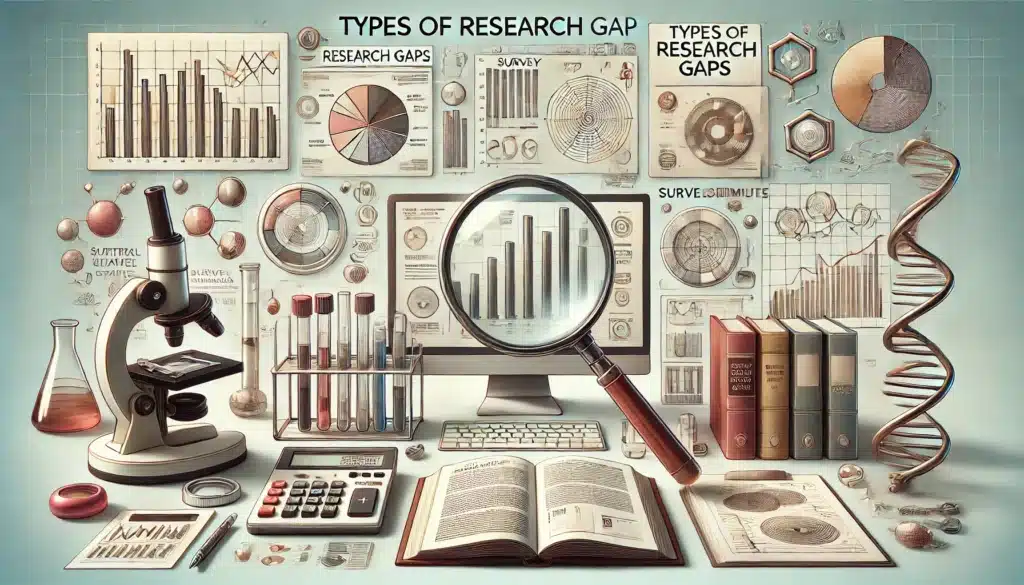A research gap is a question or a problem that has not been answered by any of the existing studies or research within your field. Here we will discuss the 12 types of research gap which are given below;
Evidence Gap
An evidence gap occurs when data is insufficient or lacks clarity regarding a specific subject. While there exists some research, the volume and quality are insufficient to draw robust conclusions. This phenomenon frequently occurs in emerging disciplines or in situations where data collection presents significant challenges.
For example, there isn’t a lot of solid empirical proof about how well restorative justice programs work for young offenders in areas with low incomes. The fact that there aren’t many longitudinal studies that look at long-term results shows that program designers don’t have enough solid evidence to help them make effective programs.
Knowledge Gap
A knowledge gap refers to a specific area where foundational understanding is insufficient or not entirely established. This represents a deficiency in our shared knowledge, rather than merely an absence of research efforts. This indicates the areas in which foundational research must be conducted prior to the initiation of more applied work.
For example, we don’t know enough about how algorithms used by social media sites affect the political division of middle-aged suburban voters. Even though a lot of study has been done on teens and young adults, we still don’t fully understand how different things affect this group.
Practice-Knowledge Gap
This gap occurs when there is a lack of alignment between the existing research literature and its practical implementations within the field. Practitioners often develop effective strategies based on their experiences, which have not been subjected to formal analysis. Conversely, methodologies grounded in research may be utilized due to various practical challenges.
For example, educational research shows that interactive activities improve student learning. However, due to a lack of training and resources, many instructors still use rote learning methods in the classroom. Conversely, some instructors use personal experiences to create effective tactics, although academic research rarely examines them. This gap shows how knowledge and action differ.
Methodological Gap
A methodological gap emerges when previous investigations employed inadequate or outdated research methodologies. This gap recognizes that the methodologies employed in the examination of phenomena significantly affect the results of our learning processes. Exploring alternative or novel methodologies may enhance our comprehension significantly.
For example, the investigators only examined police data to count domestic violence cases. However, many victims do not report incidents to law enforcement, resulting in data that fails to accurately reflect the true situation. This creates a methodological gap because the preceding technique misses hidden cases. Better methods, including private interviews, surveys, or support center statistics, would help comprehend the issue.
Population Gap

A population gap occurs when certain groups or demographics have been systematically overlooked or marginalized in research efforts. This frequently indicates a broader pattern of marginalization, wherein populations that are vulnerable or difficult to access receive insufficient research focus. This indicates a deficiency in critical information regarding significant communities.
For example, the majority of studies concerning mental health interventions focus on individuals residing in urban areas who have access to clinical services. Individuals residing in rural regions, remain under-researched despite facing distinct forms of stress and challenges in accessing services.
Theoretical Gap
A theoretical gap arises when conceptual frameworks are not fully developed or are applied inadequately to particular phenomena. This indicates that existing theories might not adequately clarify particular situations, or that new theoretical frameworks are necessary. It is challenging for researchers to conceptualize problems effectively without appropriate theoretical frameworks.
For example, youth unemployment is generally explained by comprehensive poverty theories that focus on income. However, these explanations do not explain why many educated young people are still unemployed. Existing theories fail to address skill misalignment, joblessness, and social network restrictions. Current theories fail to explain youth unemployment, indicating the need for new or modified ideas.
Empirical Gap
An empirical gap exists in instances where there is a complete absence of empirical studies or data collection in specific domains. It is probable that individuals have considered subjects in a theoretical framework yet have not put them to thorough empirical examination. This indicates a significant deficiency in systematic observation, rather than merely an insufficiency of evidence.
For example, although informal social support networks have been the subject of much theoretical discussion regarding their potential to prevent homelessness, there have been few large-scale studies that have examined how people actually use family and community resources when they are in need of housing.
Contextual Gap
A contextual gap emerges when studies performed in particular environments have not been examined across diverse cultural, geographical, or situational frameworks. Social phenomena exhibit a complex relationship with specific contexts, indicating that findings derived from one environment may not necessarily translate to others. This aspect holds significant relevance, as policies are frequently disseminated to other nations without adequately considering the contextual conditions present in those regions.
For example, research has extensively explored police-community relations in urban settings; however, there is a notable scarcity of studies addressing this phenomenon in smaller towns. In rural regions, the dynamics of law enforcement exhibit distinct characteristics when officers and community members share longstanding relationships.
Comparative Gap

A comparative gap exists due to the lack of studies that examine cross-cultural, cross-national, or cross-temporal dimensions. Conducting comparative research is essential for assessing whether findings are universal or specific to particular contexts. Identifying best practices and understanding the contextual factors that influence outcomes necessitates the implementation of systematic comparisons.
For example, many countries have tried out pilot programs for universal basic income, but there isn’t any study that compares them all. There is no study that looks at how different countries’ cultural views on work and modern welfare systems affect the results of programs there.
Contradictory Findings Gap
The existence of this gap becomes evident when contemporary studies produce conflicting or inconsistent findings concerning the identical phenomenon. Contradictions often suggest a lack of understanding rather than confirming the validity of a single set of results. Further investigation is required to figure out why and when results are different.
For example, a findings gap exists on the impact of social media on adolescents’ mental health due to conflicting findings. Certain research indicate that it causes depression and anxiety, but others assert that it facilitates connection and support among individuals. This inconsistency necessitates additional investigation to understand the variables contributing to these varied outcomes.
Temporal Gap

A temporal gap indicates research that has become outdated due to significant societal, technological, or political changes. Social phenomena are changeable, and results from prior study may not adequately reflect current circumstances. This is especially important in areas that change quickly, like how people use technology or how they work.
For example, the majority of initial studies on work-life balance were conducted in the 1980s and 1990s, a period when most households relied on a single income. These studies neglect contemporary dual-career homes, remote work technologies, and the distinctions between work and home resulting from frequent connectivity.
Practical/Application Gap
A practical gap is identified when there is insufficient investigation into the real-world implementation of theories or interventions within actual field conditions. While evidence-based practices demonstrate effectiveness in controlled settings, their relevance and applicability in complex, resource-constrained environments require further investigation. This gap indicates that professionals lack support in specific circumstances.
For example, digital learning tools are effective in classrooms under instructor supervision; however, their efficacy in schools with poor internet or outdated technology remains largely unexplored. This disparity indicates the necessity to identify methods for utilizing these technologies in resource-constrained environments.






